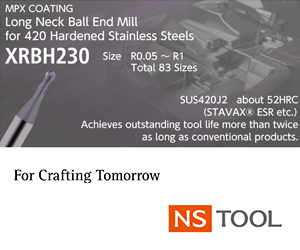
END USER: Special Quality Alloys Inc., (281) 548-1277, www.sqainc.net. SOLUTION PROVIDERS: Industrial Diamond Products Co. Inc., (713) 991-1600, www.idp-tx.com; Simonds Saw, (800) 343-1616, www.simondsint.com. CHALLENGE: Extend bandsaw blade life while reducing cycle times. SOLUTION: Back-edge ramping technology to accelerate the sawing rate.

Whether it’s machined components or sawed metal bars, customers want short lead times. On the flipside, the manufacturers producing the parts and bars desire long tool life while satisfying their customers’ expectations.
Special Quality Alloys Inc., a Humble, Texas, distributor of bars and forgings, understands those requirements. The company has three bandsaws to cut precipitation-hardened stainless steel and nickel-base superalloy bars from ½" to 19" (12.7mm to 482.6mm) in diameter with a hardness from 22 to 40 HRC, said Marco Deuterio, company president.
“We want to offer our customers good lead times. Having good saw blades and good equipment allows us to do that,” said Jimmy Carlile, SQA’s technical manager.
In a move aimed at improving bandsaw blade life, SQA allowed Houston-based distributor Industrial Diamond Products Co. Inc. to visit and test the SineWave blade from Simonds Saw, Fitchburg, Mass.


Special Quality Alloys applies SineWave bandsaw blades from Simonds to reduce cycle times while extending blade life. Image courtesy Special Quality Alloys.

A Simonds blade that can be SineWave-customized. Image courtesy Simonds Saw.

According to Simonds, its Sine-Wave blade technology features a series of tapered ramps on the back of the blade to create a rocking motion and broaching-type action in the cut for significantly faster sawing, smoother finishes, longer blade life and up to 75 percent less material waste than abrasive-cutoff methods. In addition, the technology exerts more force in the cut without having to increase machine pressure and provides ramp customization to optimize the performance when cutting a specific alloy.
Deuterio pointed out that the triple-chip, carbide-tipped SineWave blades are more expensive than conventional bimetal and carbide-tipped blades, but their ability to reduce cycle times by an estimated 30 percent or more when sawing challenging workpiece materials convinced SQA that they are worth it. “We decided we would rather go with the more-expensive blade that has a longer life and can cut through the metal than buy a cheaper blade and replace it more often,” he said.
With the SineWave technology, Deuterio said SQA tries to achieve the most-effective combination of cutting speed and blade life. “I want to reach a balance where I can get the most out of the blade but also cut fast.”
To help with that effort, Carlile said Simonds and Industrial Diamond visited SQA to educate its employees about how to better operate the company’s bandsaws, effectively monitor sawing operations and offer different blade options.
Since switching to SineWave blades, Deuterio said SQA has tested at least six or seven different blades from other manufacturers but none performed better than SineWave. Operators also sense a big difference with SineWave—sawing is faster, more aggressive and smoother.
Deuterio pointed out that if and when there are any issues with cutting performance, Industrial Diamond and Simonds personnel have always been prompt in coming onsite to investigate. In addition, they have supported SQA in blade studies to help determine optimal performance based on material grades and dimensions.
“At the end of the day, it’s about making the customer happy,” Carlile said. “As long as we continue to receive strong support from our vendors, like Industrial Diamond and Simonds, who share the same philosophy as SQA, we are able to continue providing our customers quality products with short lead times.”
Contact Details
Related Glossary Terms
- alloys
alloys
Substances having metallic properties and being composed of two or more chemical elements of which at least one is a metal.
- bandsaw
bandsaw
Machine that utilizes an endless band, normally with serrated teeth, for cutoff or contour sawing. See saw, sawing machine.
- bandsaw blade ( band)
bandsaw blade ( band)
Endless band, normally with serrated teeth, that serves as the cutting tool for cutoff or contour band machines.
- cutting speed
cutting speed
Tangential velocity on the surface of the tool or workpiece at the cutting interface. The formula for cutting speed (sfm) is tool diameter 5 0.26 5 spindle speed (rpm). The formula for feed per tooth (fpt) is table feed (ipm)/number of flutes/spindle speed (rpm). The formula for spindle speed (rpm) is cutting speed (sfm) 5 3.82/tool diameter. The formula for table feed (ipm) is feed per tooth (ftp) 5 number of tool flutes 5 spindle speed (rpm).
- hardness
hardness
Hardness is a measure of the resistance of a material to surface indentation or abrasion. There is no absolute scale for hardness. In order to express hardness quantitatively, each type of test has its own scale, which defines hardness. Indentation hardness obtained through static methods is measured by Brinell, Rockwell, Vickers and Knoop tests. Hardness without indentation is measured by a dynamic method, known as the Scleroscope test.
- sawing
sawing
Machining operation in which a powered machine, usually equipped with a blade having milled or ground teeth, is used to part material (cutoff) or give it a new shape (contour bandsawing, band machining). Four basic types of sawing operations are: hacksawing (power or manual operation in which the blade moves back and forth through the work, cutting on one of the strokes); cold or circular sawing (a rotating, circular, toothed blade parts the material much as a workshop table saw or radial-arm saw cuts wood); bandsawing (a flexible, toothed blade rides on wheels under tension and is guided through the work); and abrasive sawing (abrasive points attached to a fiber or metal backing part stock, could be considered a grinding operation).
- sawing machine ( saw)
sawing machine ( saw)
Machine designed to use a serrated-tooth blade to cut metal or other material. Comes in a wide variety of styles but takes one of four basic forms: hacksaw (a simple, rugged machine that uses a reciprocating motion to part metal or other material); cold or circular saw (powers a circular blade that cuts structural materials); bandsaw (runs an endless band; the two basic types are cutoff and contour band machines, which cut intricate contours and shapes); and abrasive cutoff saw (similar in appearance to the cold saw, but uses an abrasive disc that rotates at high speeds rather than a blade with serrated teeth).








